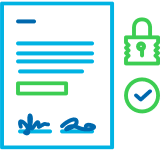
BY SPIRION
April 24, 2025
The Health Insurance Portability and Accountability Act (HIPAA) establishes strict regulations to protect patient health information (PHI). Organizations handling PHI must ensure that sensitive data is accurately identified, securely stored, and protected from unauthorized access. Many healthcare providers and organizations assume that Data Loss Prevention (DLP) solutions are sufficient to achieve HIPAA compliance, but this is a critical misconception.
DLP solutions focus on monitoring and preventing data movement, but HIPAA compliance requires proactive data discovery, classification, and lifecycle management. This article explores the limitations of DLP in meeting HIPAA requirements and how Spirion’s data discovery and classification capabilities provide the necessary compliance foundation.
Understanding HIPAA’s Core Data Protection Requirements
HIPAA enforces strict security and privacy measures for Protected Health Information (PHI). The key data protection requirements include:
- The Privacy Rule (45 CFR § 164.502) – Organizations must limit the use and disclosure of PHI to only what is necessary.
- The Security Rule (45 CFR § 164.306-164.312) – Requires safeguards to ensure the confidentiality, integrity, and availability of PHI.
- The Breach Notification Rule (45 CFR § 164.400-164.414) – Mandates that organizations identify and report PHI breaches.
- The Minimum Necessary Standard – Organizations must ensure that only the required amount of PHI is accessed or transmitted.
Meeting these requirements demands full visibility and control over PHI across all systems.
Why DLP Alone Is Not Enough for HIPAA Compliance
DLP tools are designed to prevent data from being shared outside an organization, but HIPAA compliance requires a more comprehensive data security approach. Here’s why relying solely on DLP is insufficient:
1. DLP Cannot Discover or Classify PHI
HIPAA compliance starts with knowing where PHI resides. DLP solutions only monitor data in motion and do not provide the ability to locate PHI stored across databases, file servers, cloud storage, or endpoints.
Risk: Without automated data discovery, organizations may fail to secure PHI at rest, increasing the risk of breaches and non-compliance.
2. DLP Does Not Provide PHI Access Controls
HIPAA requires that PHI access be restricted to authorized personnel. DLP solutions can block data transfers, but they do not enforce role-based access controls (RBAC) or track PHI access and usage.
Risk: Without proper access control mechanisms, organizations may violate HIPAA’s Minimum Necessary Standard and expose PHI to unauthorized users.
3. DLP Does Not Facilitate PHI Audits or Compliance Reporting
HIPAA compliance requires organizations to maintain an audit trail of PHI access, movement, and storage. DLP tools lack the capability to generate audit-ready compliance reports that track where PHI is stored, who accessed it, and when.
Risk: In the event of an audit or breach, organizations relying solely on DLP may not have sufficient documentation to prove compliance.
4. DLP Does Not Support PHI Encryption or Remediation
HIPAA mandates that organizations protect PHI using encryption and data masking techniques. While DLP can prevent unauthorized data movement, it does not apply encryption, tokenization, or redaction to PHI.
Risk: Without automated encryption and remediation, PHI remains vulnerable to internal and external threats.
5. DLP Generates False Positives, Leading to Alert Fatigue
DLP tools often flag non-sensitive data as PHI, resulting in false positives that overwhelm security teams. This can lead to ignored alerts and compliance blind spots.
Risk: When security teams suffer from alert fatigue, actual PHI exposure incidents may go undetected, leading to data breaches and HIPAA violations.
How Spirion Bridges the HIPAA Compliance Gap
Unlike DLP, Spirion provides proactive data discovery, classification, and remediation, ensuring organizations meet HIPAA requirements effectively.
- Automated PHI Discovery: Identifies PHI across structured and unstructured data environments.
- Context-Aware Classification: Accurately tags and categorizes PHI, reducing false positives.
- PHI Access Controls & Remediation: Supports role-based access controls (RBAC) and automates encryption, redaction, and remediation.
- Audit-Ready Compliance Reporting: Generates detailed compliance reports for HIPAA audits.
- Breach Prevention & Response: Helps organizations quickly identify and respond to PHI exposure incidents.
DLP Alone Cannot Ensure HIPAA Compliance
DLP is a reactive security measure, while HIPAA compliance demands proactive data governance. Organizations relying solely on DLP risk failing to meet HIPAA’s strict data security, access control, and audit requirements.
With Spirion’s automated PHI discovery, classification, and remediation, healthcare organizations can strengthen data security, reduce compliance risks, and ensure full HIPAA adherence. To learn how Spirion can enhance your HIPAA compliance strategy, request a demo today.
